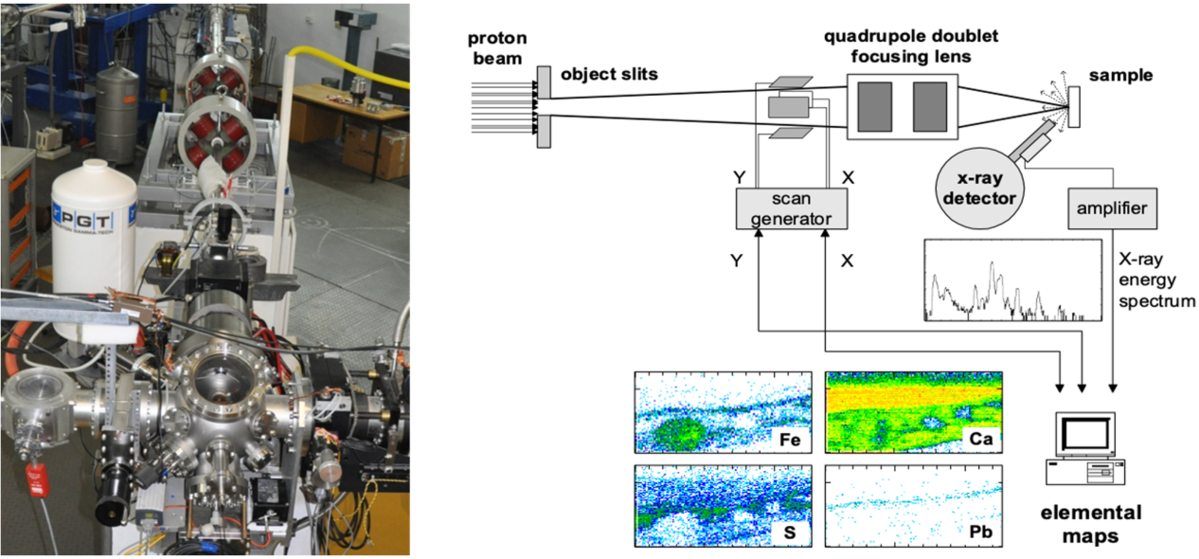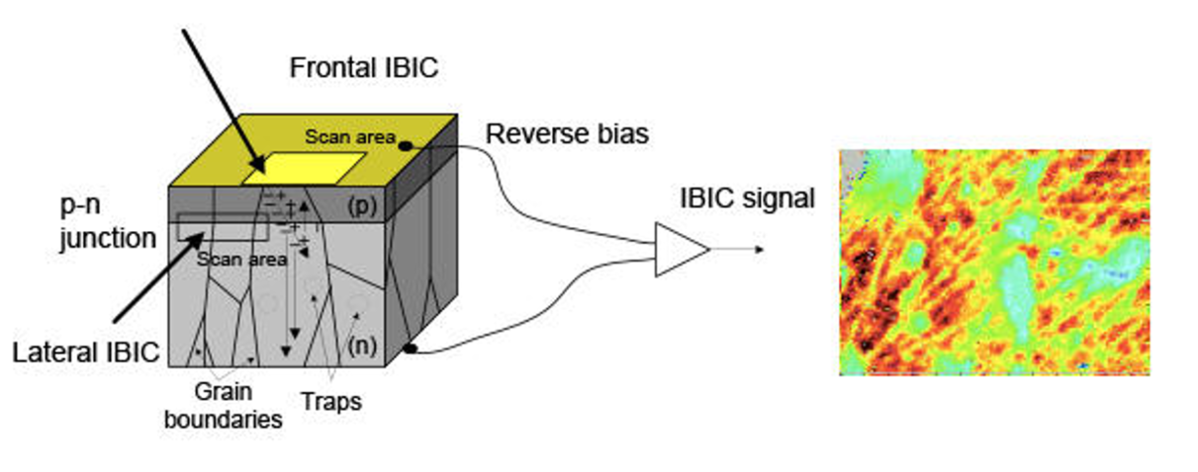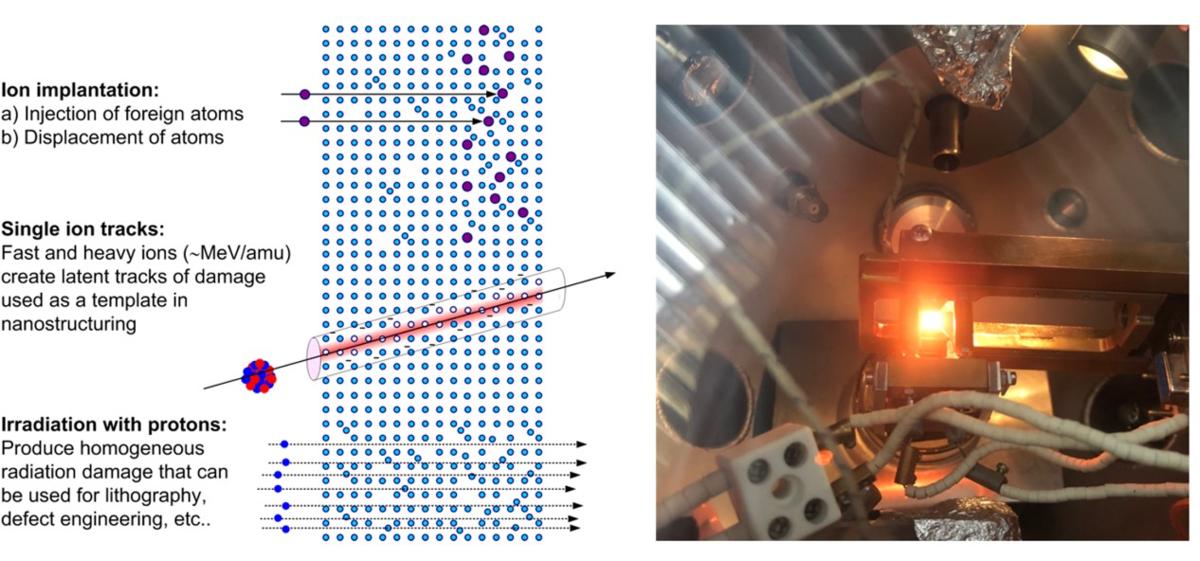Ion microprobe
An ion microprobe is a device that uses a system of quadrupole lenses to focus an ion beam to the micrometer size.
The ion microprobe beam line is probably one of the most versatile installations of its kind. Its spherical chamber and modular design enable applications of almost all available IBA techniques: PIXE, RBS, ERDA, Nuclear Reaction Analysis (NRA), IBIC, Scanning Transmission Ion Microscopy (STIM), MeV SIMS, Ion Luminescence (IL) and High Resolution-PIXE (HR–PIXE).
A focused ion beam is scanned over the sample surface (typically up to 1×1 mm2). The available beams are protons (0.4 to 8 MeV) and most of other heavier ions up to ME/q2 ratio of 15 MeV. Typical currents used for most of the ion beam analysis (IBA) techniques, such as PIXE and RBS, are between 1 and 1000 pA. The beam spot size depends on ion species being focused, their energy and current.
In the high current operation mode needed for the ion beam analysis, PIXE and/or RBS is operated by proton or He ion beam. For the ion beam analysis of light isotopes, a nuclear reaction analysis (NRA) can be used; often this is done by 3He ion microbeam. Typical spot sizes in the high current mode can be as low as 1 mm.
In the low current operation mode of the nuclear microprobe (ion beam currents < 1 fA), techniques such as STIM (scanning transmission ion microscopy) and IBIC (ion beam induced charge) are used. IBIC technique is used for imaging of transport properties in radiation detectors and other electronic devices. Ion microbeam can, in that case, be used for in situ study of materials’ radiation hardness or creation of single-event upsets in electronic circuits. For the most favourable conditions the beam spot size of the low current mode can be as low as 250 nm.
Sample viewing and positioning:Sample is viewed by a long working distance microscope with a fixed magnification (1.5 mm field of view). There is also a wide field camera (view field 2.5 cm) Samples are positioned by a 3-axis stage.
Scan control and data acquisition:Ion microbeam position is controlled by a magnetic scanner, driven by the SPECTOR software. Scanning pattern is defined either as a square or arbitrary contour. Typical resolution is 128 or 256 pixels. Scanning speed is defined by the time per pixel and is typically adjusted between 10 and 10000 ms. Maximum scan size depends on the ion beam rigidity, but generally is between 1 and 2 mm. Up to 4 ADCs are used by SPECTOR data acquisition software. Data is stored as summed spectra and elemental images (if the ion beam analysis is done), as well as a raw data list for further processing. In the case of IBIC or STIM measurements, images present average pulse height in each pixel.
Detectors:30 mm2 Si(Li) detector for PIXE, minimum sample distance 20 mm. 300 mm2 SBD for RBS (annular) positioned at the 170° back angle. 100 mm2 SBD NRA detector positioned at the 135° back angle.
Focusing system:For lower rigidity ions (up to ME/q2 = 6 MeV) Oxford triplet focusing is used. For higher rigidity ions, simple doublet is used (only the first two quadrupoles are used). For the low current mode both object and collimator slits are reduced from their default value (100 mm; 1 mm) by 10 times, reducing the current by 4 orders of magnitude or more.
Ion microbeam current:High current mode: 10 to 1000 pA
Low current mode: < 1 fA.
Scanning speed:From 10000 ms to 10 ms per pixel adjustable
Sample movement ranges:X=100 mm; Y = 25 mm; Z = 25 mm
Sample tilt:360° continuous, only around X axis
Max specimen dimensions:X = 60 mm; Y = 30 mm; Z = 10mm
Beam resolution:For most of the employed ions and energies, beam spot can be focused to a 1-2 μm profile, thus allowing the micrometer scale lateral resolution during the imaging of the sample that is being examined. However, sub-micron resolutions can be achieved. On the figure below, an example is shown where a 2 MeV proton beam was scanned over the micromachined grid with 400 nm bars. In the displayed histogram, one can see that the bars are clearly resolved in both directions. Beam resolution was calculated by fitting the “error function” on the grid bar edge (extracted from the histogram). X-direction resolution is 210 nm. Resolution worsens in the Y-direction, and was estimated around 300 nm.
HIGH CURRENT TECHNIQUES
There are plenty of sample characterisation techniques available at the RBI microprobe. These are PIXE, ERDA, RBS, NRA, PIGE, coincidence scattering, IL, MeV-SIMS, SEI, STIM and IBIC. All techniques can be used for imaging (e.g. elemental distributions), or to perform quantitative analysis at some particular point or region.
PIXE (PARTICLE INDUCED X-RAY EMISSION) SPECTROSCOPY
When charged particle (e.g. proton) moves through a material, it loses energy primarily by exciting electrons in the atoms that it passes by. Electrons in the inner shells of the atom (predominantly the K and L shells) are given enough energy to cause them to be ejected. Electrons from outer shells are filling these vacancies, which is accompanied by the emission of X-rays. The energies of these X-rays are characteristic of the element and therefore, if an appropriate detector is being used, recorded spectra can be used to identify the elemental composition of a sample being exposed by the beam. PIXE is a relatively simple and multi-elemental analytical technique that can be used to identify and quantify elements ranging from Na to U. Due to the high signal to background ratio, PIXE is also nondestructive technique and very sensitive and for a wide range of measured elements with detection limits close to 1 ppm (part-per-million).
RBS (RUTHERFORD BACKSCATTERING SPECTROMETRY)
By measuring the energy and intensity of a backscattered beam of high energy ions (typically protons and alpha particles), impinging on a sample it is possible to determine the composition and depth profile of elements at the sample surface and below. Although the technique can be used to quantify major sample elements (except hydrogen) and as such is complementary to PIXE, RBS is particularly useful for the depth profiling. The best results are obtained for the depth profiling of heavy elements in light substrates.
NRA (NUCLEAR REACTION ANALYSIS) AND PIGE (PARTICLE INDUCED GAMMA RAY EMISSION)
When a fast ion (typically proton) approaches the nucleus of a target atom, the Coulomb force usually repels it. However, when the incident particle has enough energy to overcome the repulsive Coulomb force a charged particle then penetrates through the electrostatic barrier into the nucleus, resulting in interactions with the nuclear forces. If a nuclear reaction occurs, it can result in the emission of particles and/or gamma rays. Detection of particles (usually done by Si particle detector) – is a basis of NRA, while detection of gamma rays (typically by large volume Ge detectors) is a basis of PIGE. Both techniques can run in conjunction with PIXE and RBS and are mostly used to quantify concentrations of low Z elements such as: Li, Be, B, C, N, O, F, Na, Mg and Al.
LOW CURRENT TECHNIQUES
STIM (SCANNING TRANSMISSION ION MICROSCOPY)
Ions penetrating the material undergo numerous interactions with the target electrons and nuclei. They lose their energy and are being slowed down. The ion energy loss depends on the ion velocity and its charge (not on the ion mass) as well as on target material. By measuring the energy of transmitted ion at some particular sample position, its structure and density variations within the sample can be studied. By using different ion species and their respective energies, a wide range of sample thicknesses can be studied.
IBIC (ION BEAM INDUCED CHARGE)
Fast moving ions interact with the electrons of atoms in the material creating numerous ionizations along their trajectories. If ions are being stopped in the semiconductor device, created charge pairs may drift in the built in electric field (e.g. pn junction) or in field that is externally. This will induce a measurable charge signal at the electrodes. By correlating ion position (using nuclear microprobe system) with signal height, images of charge collection properties are obtained. In addition to IBIC imaging, the technique is suitable for quantifying the transport parameters of the charge carriers in materials being tested. By possibility to inject different ion species with different respective energies, IBIC can also probe electronic transport at different sample depths.
MATERIALS MODIFICATION
In addition to characterisation, focussed MeV ion beams could be also used for materials modification. Proton microbeam could be used for direct writing lithography (e.g. resists as PMMA), or to induce homogeneous regions of radiation damage with reliable control of ion fluence. Heavier ions could be implanted to a certain depth in the sample. A wide span of fluences could be used, from single ions (e.g. luminescence centres) up to extremely high fluence densities (e.g. induction of graphitic lines in diamond by C-ion implantation). On the picture below one can see the in-chamber view during the diamond implantation process. The sample is heated to 750 °C.







